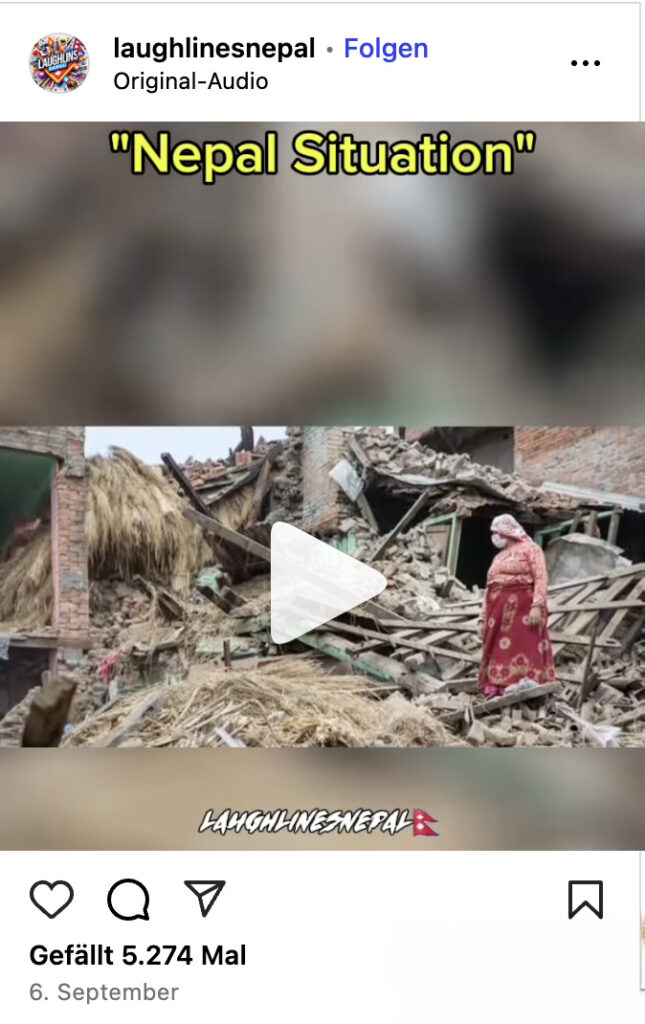Mass surveillance is not about public safety. It is not about terrorism. It is about power. It is about economic espionage. It is about diplomatic manipulation. It is about social influence.
– Edward Snowden1
When Edward Snowden revealed the scope of state surveillance, he warned against a future where governments treat digital life as public property. In Nepal, that future arrived not through secret programs but through public policy. The Nepal Social Media Ban, implemented through a sweeping regulation bill and the subsequent blocking of 26 platforms, transformed online life into an overt instrument of control. What began as a bureaucratic measure ignited one of the most significant youth-led protests in recent memory.
At its core, Nepal social media ban highlight a paradox: the same tools that empower people to connect, organize, and challenge inequality can be stripped away by governments under the guise of regulation. This is not just Nepal’s dilemma but a global struggle, whether digital spaces will serve citizens, corporations, or states.
Cutting Connectivity, Sparking Resistance
The turning point came in August 2025, when Nepal’s Supreme Court ordered the government to introduce legislation to prevent unregistered digital platforms from operating. Although not a complete ban, it gave the government a clear opportunity to tighten its control over social media.
At the same time, the Prime Minister and his government had already encountered widespread accusations of corruption and creeping authoritarianism before passing the bill. By mid-2025, the battle had reached a turning point: the government was no longer just facing Big Tech; it was also facing a public that had made social media its loudest platform. TikTok parodies, YouTube exposés, and anonymous posts on X were chipping away at the government’s credibility.
The government issued a stark ultimatum to social media platforms: register locally or face a ban. Come September, the threat became reality: 26 platforms were blocked almost overnight. Officials framed it as a matter of enforcing rules, but to many, it felt like a blatant attempt to stifle dissent. The effects were immediate and widespread: businesses lost access to customers, online classes were interrupted, content creators were silenced, and the very young population the authorities feared most took to the streets in protest.
Almost immediately after the restrictions were announced, some young Nepalis used VPNs and DNS changes to bypass them, while private groups on Discord and Telegram became alternative town squares. Many others, older adults or youth without advanced digital tools struggled to adapt. For them, staying connected meant relying on Wi-Fi calls or familiar smartphone apps, revealing the persistent digital divide shaping daily life in Nepal.
What began as a peaceful protest quickly escalated. Police opened fire, and parts of the streets were set ablaze. A demonstration meant to express dissent became a scene of chaos and fear, with young Nepalis caught at the center.
Technology became both the spark and the conduit for a protest that defied structure, hierarchy, or political backing. The youth, frustrated by a system they could not navigate and a government they could not trust, found a voice in social media. Algorithms amplified outrage, messages spread with unprecedented speed, and digital platforms became the streets of a new kind of assembly, one without leaders, without manifestos, without defined paths.
Scrolling Through Inequality
Nepal has long been a country where power is concentrated in the hands of a few. The children of these elites often enjoy extravagant lifestyles, many of them abroad. On social media, they flaunt wealth and access unimaginable for most at home. For ordinary Nepalis, these posts are more than harmless displays, they became even more striking in the wake of the Nepal social media ban, a reminder of a system where family ties, not merit, decide who rises to power.
A large share of the population also lives abroad, but their lives look very different. While elites post from luxury apartments, a migrant worker supports their family through long hours and sacrifice. Their journey is one of survival and perseverance, not glamour. For Nepal’s youth, social media has become a stage to bridge this gap, a place to mock privilege, question merit, and call out a political system that too often feels like a family business. The 2025 Nepal social media ban highlighted just how crucial these digital platforms are for connecting lives and voices across borders.
Since August 2025, TikTok and Instagram in Nepal have been flooded with clips contrasting the lavish lives of elites with the daily struggles of ordinary people, a digital mirror of the country’s harsh inequalities. Every day, around two thousand Nepalis leave in search of work, while more than 80 percent of those at home labor in the informal sector as domestic servants, street hawkers, porters, or cleaners 2, and youth unemployment in the formal economy remains above 20 percent 3.
Migration has become the default, with Nepalis working as mercenaries in Ukraine, building Qatar’s World Cup infrastructure, or taking seasonal jobs in India. Over 14 percent of the population now lives abroad 4, and remittances account for nearly a third of GDP.
For families scattered across continents, platforms like WhatsApp and Facebook are not luxuries but lifelines. The Nepal social media ban didn’t just disrupt entertainment or business, it cut off vital connections between parents and children, spouses, and siblings trying to stay together across borders.
Growth Meets State Control
Nepal’s digital economy had been expanding rapidly. From rural agriculture programs under FAO’s Digital Village Initiative (DVI) 5 to the World Bank-funded Digital Nepal Acceleration Project (DNA) 6, technology was marketed as the engine of growth. Informal entrepreneurs relied on Instagram shops and TikTok promotions.
Yet in a country with fragile democratic safeguards, regulation tilted toward control rather than accountability. The Social Media Bill gave sweeping powers: platforms would be required to register locally, maintain offices in Nepal, and appoint grievance officers. But the provisions went far beyond simple regulation. The bill grants sweeping powers to authorities, users posting anonymously could face imprisonment, misleading or ‘indecent’ content could trigger fines of up to 10 million rupees, and platforms could be forced to remove content without any judicial oversight, highlighting the impact of social media bans.
One could argue that rather than regulating digital spaces, the bill effectively creates tools for censorship, giving the state unprecedented control over online expression and leaving ordinary users vulnerable to severe penalties.
The Promise and Peril of Technology in a Divided World
There was no clear blueprint or guidance. People came together out of frustration, but without defined leadership or specific demands, the movement around the Nepal social media ban unfolded in a spontaneous way. This energy gave the protests strength, but it also meant that events sometimes took directions no one had anticipated, drawing in both public spaces and everyday life.
Technology had democratized power and, in doing so, it also democratized chaos. When everyone could speak, no single voice commanded clarity. When everyone could act, no one could steer the course. Anonymity and constant connectivity created a paradox: the more power people felt, the harder it became to control the crowd. The impact of social media bans became evident as what began as a call for accountability turned into an uncontrollable force, a mirror of the limits of digital-enabled action in a world unprepared for its intensity.
There is a warning here: technology does not guide intention; it magnifies it. Without strategy or reflection, even the most justified frustration can spiral into chaos.
That is why it mattered when Nepal’s youth turned to Discord, a platform for gamers, to attempt something no democracy had tried before: electing an interim prime minister through a virtual poll. For them, it was a way to reclaim trust in politics.
Yet as Parliament quietly lets the social media bill linger, a bigger question remains: will Nepal’s leaders truly hold global tech giants accountable or use regulation to silence their own people?
Why Nepal Matters
From Edward Snowden’s revelations to Nepal’s social media regulations, the thread is familiar: technology that promises connection and opportunity can also become a tool of oversight and control. The Nepal Social Media Ban illustrates this tension, showing how inequality is amplified when elites hoard power and wealth, and digital platforms expose the gap between those who shape policy and those who live its consequences. Across the world, governments have recognized the potential of digital tools not just for governance, but for influence: to monitor citizens, shape narratives, and suppress dissent.
Nepal’s experience is a microcosm of a larger pattern, where the same networks that empower voices can be turned into instruments of surveillance, reinforcing hierarchies and keeping populations under watchful eyes.
References
Thanks to हिमाल सुवेदी @ Wikimedia Commons for the header image!
- Snowden, E. (n.d.). Quotes by Edward Snowden (Author of Permanent Record). Goodreads. Retrieved September 24, 2025, from https://www.goodreads.com/author/quotes/7140597.Edward_Snowden
- World Bank. (n.d.). Nepal Overview: Development news, research, data. World Bank. Retrieved September 24, 2025, from https://www.worldbank.org/en/country/nepal/overview
- Macrotrends. (n.d.). Nepal Youth Unemployment Rate (1991-2024). Macrotrends. Retrieved September 24, 2025, from https://www.macrotrends.net/global-metrics/countries/npl/nepal/youth-unemployment-rate
- MIDEQ. (n.d.). Nepal Brief. Research Context. https://southsouth.contentfiles.net/media/documents/MIDEQ_Nepal_brief_v2.pdf
- FAO. (n.d.). DVI in Nepal. Digital Villages Initiative in Asia and the Pacific. https://www.fao.org/digital-villages-initiative/asia-pacific/country-briefs/dvi-in-nepal/en
- World Bank. (n.d.). Nepal – Digital Nepal Acceleration (DNA) Project. World bank Group. https://documents.worldbank.org/en/publication/documents-reports/documentdetail/995101654266502751/nepal-digital-nepal-acceleration-dna-project









